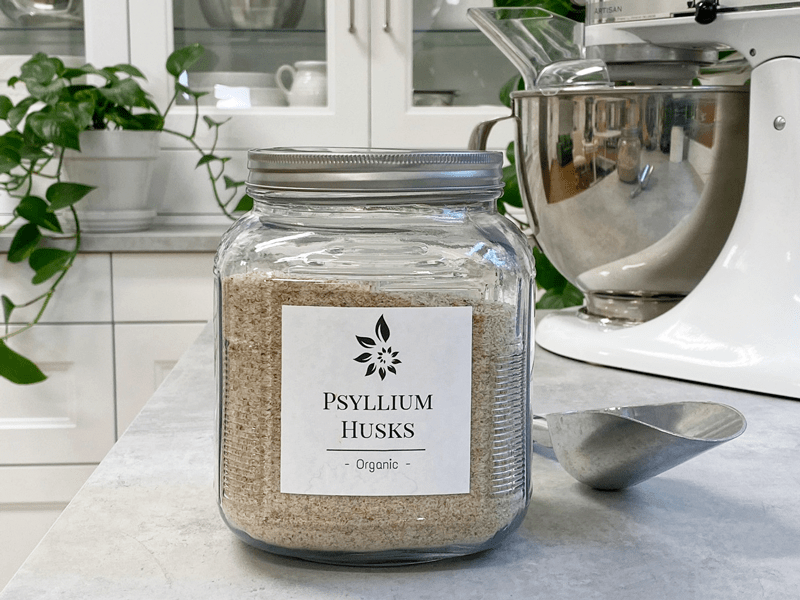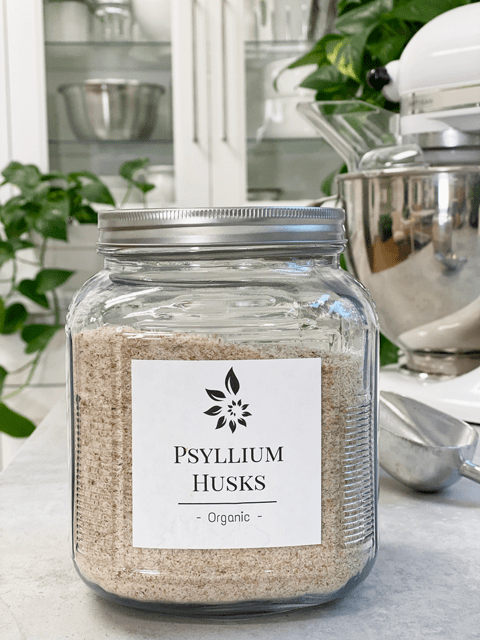Psyllium (thickener)

 Add to favorites
Add to favorites
Are you looking for a way to thicken your recipes plus have the added benefits of nutrition? Psyllium is a wonderful option that delivers both.

What is psyllium?
- It is available as coarse “husks” or finely ground.
- Psyllium seed husks contain both soluble and insoluble fiber. The soluble fiber dissolves in water and soothes the digestive tract with its mucilaginous properties, while the insoluble fiber acts like a broom to sweep the colon free of toxins.
- Pure psyllium seed husk contains no gluten. The psyllium plant is not a wheat. Look for a premium, pure product with no additives if you are on a celiac diet.
- Psyllium seed husks are one of nature’s most absorbent fibers, able to suck up over ten times their weight in water.
Health Benefits:
- 1 ounce has: Calories 91 / Fat 0 g / Carb 22.7 g / Fiber 22.7 g / Protein 0 g
- Studies have shown that psyllium relieves constipation. When combined with water, it swells and produces more bulk, which stimulates the intestines to contract and helps speed the passage of stool through the digestive tract.
- Due to the fiber in psyllium, it has been shown that a high fiber diet may help lower insulin and blood sugar levels and improve cholesterol levels in people with diabetes.
- Studies also show that a diet high in water-soluble fiber is associated with lower triglyceride levels and a lower risk of cardiovascular disease.
- Be sure to increase your water intake when eating foods that include psyllium.
High-Quality Brands
 How do I use psyllium?
How do I use psyllium?
- You can use it as an egg substitute in recipes.
- It can be used to thicken and give body to fillings, puddings, and sauces. Once added to a recipe, allow the ingredients to sit for 10+ minutes. This gives the psyllium time to activate and thicken.
- For best results, use a maximum of 1 tsp of ground psyllium per 2 cups total recipe volume. Whisk or blend briefly into a recipe. Be careful to not over-blend.
Disclaimer
This website is not intended to provide medical advice. All content, including text, graphics, images, and information available on this site is for general informational, entertainment, and educational purposes only.
The content is not intended to be a substitute for professional diagnosis or treatment. The author of this site is not responsible for any adverse effects that may occur from the application of the information on this site.
You are encouraged to make your own healthcare decisions, based on your research and in partnership with a qualified healthcare professional.
© AmieSue.com



 Add to favorites
Add to favorites

 How do I use psyllium?
How do I use psyllium?
Hi Sue,
Why does the recipe need to be chilled? Does the psyllium expand better in the cold?
I am playing around with a biscuit recipe and am trying to replace the egg and baking soda with the psyllium.
Thank you for your insights,
Gudula
What recipe Gudula?
Hi Amie-Sue
Under “how do I use psyllium”, third paragraph you mentioned to at least let the recipe (I am assuming any recipe using psyllium) chill for 2 hours.
Thank you!
Gudula
Gotcha Gudula…. it will always depend on what you are incorporating it into. The psyllium is a great thickener and sometimes need to time to set up. I am going to remove that from the paragraph because it sounds confusing with out detailed information. Just take it recipe by recipe, once it reach the right texture you are good to go. :) amie sue
Amie Sue,
I am allergic to psyllium husk. Do you have a recommendation for an alternate thickener? Will additional flax seed work?
I made your Blackberry “Cheese”cake for my daughter’s bridal shower and many had no idea it wasn’t cheese! I received many compliments. Two years later, she’s requesting it for her birthday cake.
Thank you!
Linda
Hello Linda,
Sorry to hear about your allergy. Ground flax or chia seeds can be a good option, it would depend on the recipe.
Raw cheesecakes are amazing, aren’t they!? Happy to hear that it was a hit. I appreciate you sharing. :) Blessings, amie sue